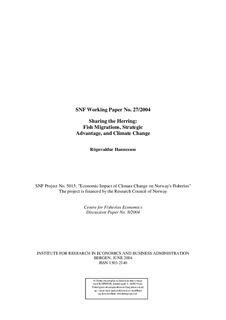| dc.contributor.author | Hannesson, Rögnvaldur | |
| dc.date.accessioned | 2006-06-26T17:47:58Z | |
| dc.date.available | 2006-06-26T17:47:58Z | |
| dc.date.issued | 2004-06 | |
| dc.identifier.issn | 1503-2140 | |
| dc.identifier.uri | http://hdl.handle.net/11250/166434 | |
| dc.description.abstract | This paper analyzes the strategic options of Norway and other countries for which the stock of Norwegian spring spawning herring may be accessible. A cooperative solution would make all parties better off. In a cooperative solution Norway must obtain a relatively large share of the total catch quota, because of her strategic advantage. The critical share to be offered to Norway does not have anything to do with the zonal attachment of the stock, interpreted as the share of the stock within the Norwegian economic zone. A rise in the temperature in the Northeast Atlantic could mean a larger carrying capacity for the stock and more extensive migration. This in turn would mean a less strong attachment of the stock to the Norwegian economic zone, strengthening the bargaining position of other parties than Norway. | en |
| dc.format.extent | 73954 bytes | |
| dc.format.mimetype | application/pdf | |
| dc.language.iso | eng | en |
| dc.publisher | SNF/Centre for Fisheries Economics | en |
| dc.relation.ispartofseries | Working paper | en |
| dc.relation.ispartofseries | 2004:27 | en |
| dc.relation.ispartofseries | Discussion paper | en |
| dc.relation.ispartofseries | 2004:8 | en |
| dc.title | Sharing the herring : fish migrations, strategic advantage, and climate change | en |
| dc.type | Working paper | en |
